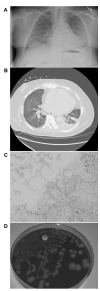Strongyloidiasis in transplant patients
- PMID: 19807271
- PMCID: PMC2913967
- DOI: 10.1086/630201
Strongyloidiasis in transplant patients
Abstract
Strongyloides stercoralis is an intestinal nematode that can persist in the human host for decades after the initial infection and can progress to fulminant hyperinfection syndrome in immunocompromised hosts. We describe a patient who died of Strongyloides hyperinfection syndrome 2 months after orthotopic heart transplantation and discuss approaches to prevention, diagnosis, and treatment. Current practice guidelines recommend screening for and treatment of Strongyloides infection before transplantation, but physicians in the United States often miss opportunities to identify patients with chronic strongyloidiasis. Screening tests have limitations, and clinical suspicion remains an important component of the evaluation before transplantation. After immunocompromised patients develop hyperinfection syndrome, diagnosis is often delayed and mortality is high, so emphasis must be placed on screening and treatment before transplantation. We review current strategies for prevention, diagnosis, and treatment of chronic intestinal strongyloidiasis in patients who will undergo transplantation and discuss the clinical features and management of Strongyloides hyperinfection syndrome in transplant recipients.
Figures


References
-
- Liu LX, Weller PF. Strongyloidiasis and other intestinal nematode infections. Infect Dis Clin North Am. 1993;7:655–82. - PubMed
-
- Gill GV, Beeching NJ, Khoo S, et al. A British Second World War veteran with disseminated strongyloidiasis. Trans R Soc Trop Med Hyg. 2004;98:382–6. - PubMed
-
- Olsen A, van Lieshout L, Marti H, et al. Strongyloidiasis—the most neglected of the neglected tropical diseases? Trans R Soc Trop Med Hyg. 2009 published online March 26. - PubMed
-
- Ungar BL, Iscoe E, Cutler J, Bartlett JG. Intestinal parasites in a migrant farmworker population. Arch Intern Med. 1986;146:513–5. - PubMed
-
- Berk SL, Verghese A, Alvarez S, Hall K, Smith B. Clinical and epidemiologic features of strongyloidiasis: a prospective study in rural Tennessee. Arch Intern Med. 1987;147:1257–61. - PubMed
Publication types
MeSH terms
Grants and funding
LinkOut - more resources
Full Text Sources
Medical

